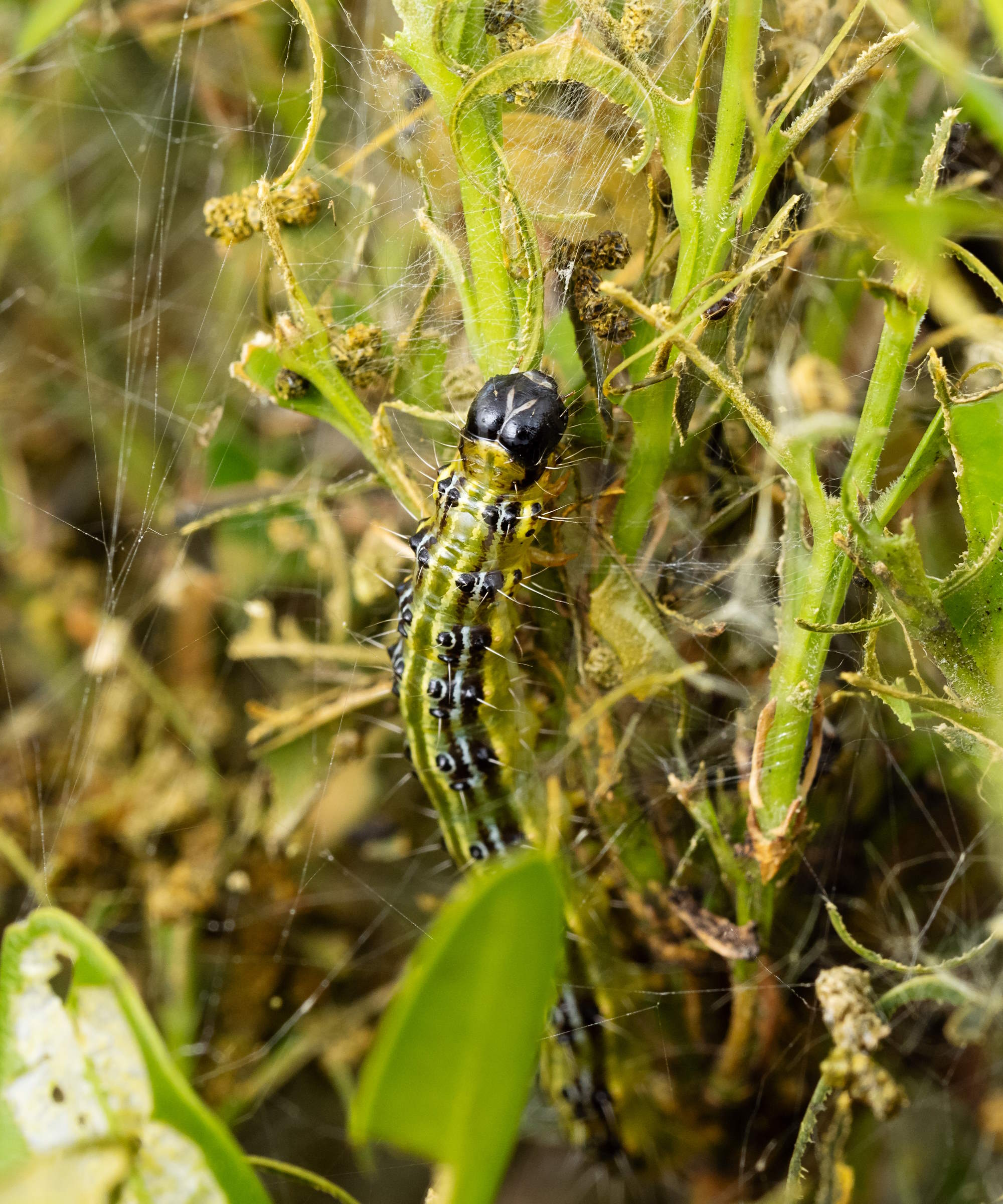What is a box tree moth? Discover the damage box moths and box caterpillars can cause, and how to spot them
Box tree moths are an invasive pest that arrived in the US in recent years after wreaking havoc in Europe


Box tree moths (Cydalima perspectalis) are invasive pests native to Asia. They have spread throughout Europe over the last 15 years and caused lots of damage to boxwood plants.
They arrived on US shores in 2021 when the first presence of box tree moths was reported in New York. The pests are now confirmed in Michigan and Ohio and could spread further as they breed prolifically and fly long distances.
Boxwoods are popular evergreen plants used in urban plantings and as part of many people’s backyards. To help you spot if the pests arrive in your area, we explain what box tree moths and box caterpillars look like and the damage they cause. If you do discover an outbreak of the pest, it does need to be reported to state officials.

Box tree moths awaken in the spring
What does a box tree moth look like?
A box tree moth is a medium-sized moth with white wings that have a distinctive brown border. Box caterpillars are the moth’s larvae. They are around 1-1.5 inches long and green and yellow, with black heads, and the bodies of box caterpillars feature thin black and white stripes. While the pests themselves have distinguishing characteristics, you may not realize you have a problem until you spot signs of damage on your plants.
Signs of box tree moth damage

Box caterpillars leave webbing on plants
Early identification of box caterpillars can help to potentially eradicate any issue. Spotting the signs of early damage means you can act fast, as box tree moths have a fast life cycle and can produce several generations from spring until fall. Dr Tracy Ellis, an entomologist at Farm Sense, recommends: ‘Focus on the host plant boxwood to check for any feeding damage by the immature stage larvae throughout the spring, summer and fall.’
The presence of the caterpillars in the plant, and the distinctive moths on or around the boxwood, will be an obvious sign. However, there are also some other tell-tale symptoms to keep a close eye on for box caterpillars, such as:
- Webbing – The caterpillars are vociferous eaters and produce webbing over the areas in which they feed. Leaves can be covered and stuck together with this webbing.
- Dieback – Box plants will suffer from patches of dieback where the caterpillars have fed. The affected leaves can be papery and pale.
- Defoliation – As the caterpillars munch their way through leaves they can defoliate plants and leave behind skeletal leaves on the plants.
- Frass – Frass is another term for caterpillar droppings and this can be seen as dark brown and black flakes that collect on the leaves.
- Pupae – As the caterpillar changes into the moth, the pupae can be hidden inside the plant, tucked behind a cocoon of white webbing.
- Eggs – As well as the developing pupae, the eggs can also be seen on the underside of leaves. These eggs are small and yellow and will overlap each other.
- Stripped bark – Box tree moths themselves can strip the bark from boxwood plants and bore into the bark of older plants.
It can sometimes be tricky to differentiate between the symptoms of box blight and box caterpillar – especially when it comes to dieback and discoloring as boxwood can turn yellow due to blight and pest damage.
Design expertise in your inbox – from inspiring decorating ideas and beautiful celebrity homes to practical gardening advice and shopping round-ups.
Dr Tracy Ellis recommends that any abnormalities in the shape or color of your boxwood ‘should be followed up with a closer look’ to identify if the issues are due to disease or box caterpillar.
She says: ‘If you account for the leaves such as yellowed leaves on the stems or empty stems because of leaf drop (leaves under the bush on the ground) it will not be a box tree moth.
‘If the abnormalities consist of missing leaves, partially missing leaves covered with webbing and a ground pepper-like material (boxwood tree moth excrement), it may be because the box tree moth larvae have been living on your boxwood.’

Dr. Tracy Ellis is an award winning entomologist at FarmSense. She has extensive experience in working with farmers, government agencies, stakeholders, and communities surrounding pest detection, monitoring, regulation, and suppression tactics. Her research has significantly impacted biopesticide discovery, innovation, and commercialization.
Box tree moth treatment options

Keep your eyes peeled for signs of box caterpillars
Box tree moths are a new pest in the US and are a regulated species that needs to be reported to the state regulators. Dr Tracy Ellis says: ‘Currently box tree moth is a reportable quarantine pest and should be reported to your local USDA office or State agriculture department.
‘The agencies may undertake eradication procedures and be able to give you instructions on appropriate measures to take. Once the pest becomes established in your area and has arrived ahead of any natural predators or parasitoids to get it under natural control, you may need to regularly treat your boxwood with an insecticide to protect it, using insecticide advice from your local state extension agent.’
Given how box caterpillars and box tree moths can decimate boxwood plants quickly, you will surely wonder how to get rid of box tree moths. The approach taken will likely depend on the size of the infestation.
A small outbreak can be dealt with by removing them by hand and checking daily to remove any more you spot – taking care to check deep into the center of the boxwood. Companion planting can be utilized to bring wildlife and natural predators into the garden to help you deal with any moth or caterpillar issues. Spraying insecticidal soap, homemade bug sprays, or neem oil, can help with young caterpillars too.
There are certain products and measures available in other countries where box caterpillar has been a problem. One example is box tree moth traps, that can be placed around the plants. These products contain the pheromone of a female box tree moth and male specimens will be attracted and get stuck inside the trap. This helps prevent breeding, as female eggs cannot be fertilized, but cannot be relied on to remove all box tree moths and a generation of caterpillars may remain on the plants. Any box moth traps will need to be replaced regularly, around every six weeks.
There are also biological controls that professionals can apply to affected plants and some chemical controls that can be used by home gardeners that can help, but potentially not completely eradicate, the issue. Beneficial nematodes can also be applied, that contain a natural predator of the caterpillars which can infect and kill the pest.
FAQs
Do box tree moths eat other plants?
Box tree moths feed on all species of boxwood. Research has shown that they also eat varieties of euonymus, but not to the same extent as they ravage box. And, while they did nibble euonymus in the research, they did not reproduce on the plant.
Can a box tree recover from caterpillar damage?
Boxwood can recover from damage if it is identified early. The pests are capable of stripping and decimating a box tree in rapid time. Whether the plant recovers fully will depend on how damaged it gets.
There is no need to panic if you have a parterre garden that features boxwood, or lots of topiary as part of your backyard ideas – as boxwood remains a popular plant for topiary. The take-home point is to be vigilant, keep an eye out for any potential issues, and report any pests if do see any of the signs of damage.

Drew has worked as a writer since 2008 and was also a professional gardener for many years. As a trained horticulturist, he worked in prestigious historic gardens, including Hanbury Hall and the world-famous Hidcote Manor Garden. He also spent time as a specialist kitchen gardener at Soho Farmhouse and Netherby Hall, where he grew vegetables, fruit, herbs, and cut flowers for restaurants. Drew has written for numerous print and online publications and is an allotment holder and garden blogger. He is shortlisted for the Digital Gardening Writer of the Year at the 2025 Garden Media Guild Awards.
